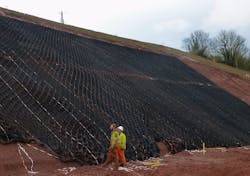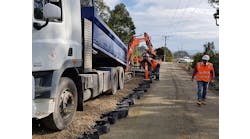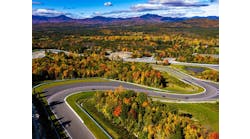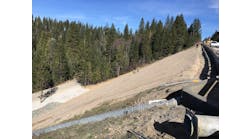A $10.3 million project in Devon, U.K., necessitated the reconstruction of a half-mile single-lane road designed to reduce congestion and support economic development in the area. The approved route required a significant amount of material (nearly 131,000 cu yd) on adjacent slopes to be excavated to allow room for the new roadway. Cutting back the embankments created steep slopes that, when left unprotected, were prone to sloughing and erosion issues caused by water and erosive soils.
Extensive embankment stabilization was required to keep the upper soil layer stable and to reduce the potential for erosion and soil movement. Two dimensional planar ‘cover only’ systems (e.g. erosion control blankets, turf reinforcement mats) were evaluated, but concern that water and soil could migrate under these materials and cause the same erosion issues, as well as the two-dimensional products’ inability to hold infill in place on the steep slope, deemed them an unacceptable option for this site.
The Presto Geoweb soil stabilization system was selected to stabilize the embankments. Through confinement of infill materials in its interconnected cellular network, the 3-D system provides stability of the upper slope layer. The 3-D system performs like a series of check dams, keeping soil confined to resist sliding and movement from gravity as well as preventing severe erosion caused by storm water infiltration and saturation of surface soils. The steep angle of the cut slopes warranted a robust solution to provide safe, secure stabilization of the infill over the slope face. For this project, 6-in.-deep material was utilized to ensure sufficient depth of stabilization.
To assure complete system stability under infill loading, high-strength tendons with load transfer devices (ATRA tendon clips) were utilized. The tendon clips transfer slope gravity forces from the Geoweb cell walls to the tendons, reducing loading stress on the overall slope cover system. The tendon clips engage securely with the Geoweb cell walls, for a ’locked-in-place’, strong pull-through strength. A looped tie-off assures that tendons stay bound to the load transfer device during installation.
Once the 48,500 sq ft of Geoweb panels and integrated tendon anchoring system were securely positioned on the slope, infilling operations began utilizing on-site reddish color material chosen to blend with the natural underlying sandstone. Infill was delivered by a front end loader at the crest of the slope to the toe, and raked into the cells across the slope face. Controlled overfilling of cells was allowed for some consolidation and compaction of the infill.
The Geoweb material’s perforated cell walls allow infill interlock between cell walls and promote lateral drainage of water. This was an important factor in choosing the Geoweb solution for this site due to the positioning of the cutting and potential water flow issues.
Months after initial installation, the now stable embankment is permanently green and rich with the selected vegetation.



